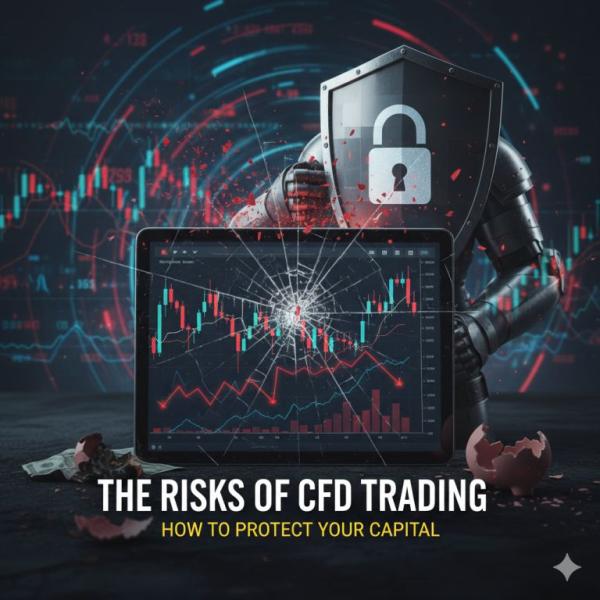The Risks of CFD Trading: How to Protect Your Capital
Contracts for Difference (CFDs) have become a popular way for traders to access financial markets without owning the underlying assets. They offer flexibility, leverage, and the potential for substantial returns, but these advantages come with significant risks.
Understanding these risks is crucial for anyone considering CFD trading, as the wrong approach can quickly erode capital.
In this article, we will explore the key risks associated with CFD trading and provide actionable strategies to protect your investment while making informed trading decisions.
Understanding CFDs and Their Appeal
Before diving into the risks, it is important to grasp the basic concept of CFDs. For those unfamiliar, the CFD meaning refers to a derivative financial instrument that allows traders to speculate on price movements of assets like stocks, commodities, indices, and currencies without actually owning them. Essentially, a CFD is a contract between a trader and a broker, where the difference in the asset’s price from the time the contract is opened to the time it is closed determines the profit or loss.
The appeal of CFDs lies in their flexibility. Traders can take both long and short positions, allowing them to potentially profit from rising or falling markets. Additionally, CFDs often offer leverage, meaning traders can control larger positions with a relatively small amount of capital. While this magnifies potential gains, it also increases potential losses, making risk management essential.
The Inherent Risks of CFD Trading
CFD trading is inherently risky, and new traders often underestimate the challenges. One of the primary risks is leverage risk. Leverage amplifies both profits and losses. A relatively small adverse movement in the market can lead to losses exceeding the initial investment, especially if positions are highly leveraged. For example, a 5% drop in an asset’s value can translate into a 50% loss if the leverage is 10:1. Understanding leverage and using it judiciously is key to protecting your capital.
Another significant risk is market volatility. CFD prices fluctuate constantly, and sudden price swings can trigger margin calls or stop-outs. Market volatility can result from economic events, geopolitical tensions, earnings announcements, or unexpected news. Traders must be prepared for rapid market movements and have strategies in place to mitigate potential losses.
Counterparty risk is another important consideration. Since CFDs are over-the-counter instruments, the broker acts as the counterparty to all trades. This means that if the broker becomes insolvent or fails to meet its obligations, the trader could suffer losses regardless of market movements. Choosing a reputable, regulated broker is a critical step in minimising this risk.
Strategies to Protect Your Capital
Given the risks associated with CFD trading, implementing effective risk management strategies is crucial. One of the most fundamental tools is the stop-loss order. A stop-loss order automatically closes a position when the price reaches a predetermined level, helping to limit losses. Traders should determine stop-loss levels based on both market conditions and personal risk tolerance, rather than arbitrarily.
Position sizing is another critical factor in protecting capital. Traders should never risk more than a small percentage of their account balance on a single trade. Many professionals suggest risking no more than 1-2% of your total capital per trade. By controlling position size, traders can survive losing streaks without depleting their accounts.
Diversification can also help mitigate risk. By spreading trades across different assets or markets, traders reduce the impact of a single adverse event on their portfolio. While diversification does not eliminate risk, it provides a buffer against extreme losses.
Regular monitoring and analysis are vital for managing CFD trades effectively. Markets are dynamic, and conditions can change rapidly. Keeping abreast of news, economic data, and market trends allows traders to adjust strategies proactively. Technical and fundamental analysis can guide decisions, helping traders identify potential entry and exit points with greater precision.
The Role of Discipline and Emotional Control
Even the most sophisticated strategies cannot fully protect against losses if traders lack discipline. Emotional control is a cornerstone of risk management. Avoiding impulsive trades, sticking to predefined plans, and maintaining realistic expectations are all part of a disciplined approach. Traders should also recognise when it is necessary to step back from the market, especially during periods of high volatility or after a series of losses.
Maintaining a trading journal can reinforce discipline. Recording entry and exit points, reasoning for trades, and lessons learned helps identify patterns in behaviour and decision-making. Over time, this practice fosters self-awareness and reduces the likelihood of repeating costly mistakes.
Conclusion
CFD trading offers exciting opportunities for traders to engage with global markets, but it comes with significant risks that require careful management. Leverage, market volatility, counterparty exposure, and psychological factors can all threaten capital if not addressed appropriately. By understanding the CFD meaning, implementing robust risk management strategies such as stop-losses, position sizing, and diversification, and maintaining discipline, traders can mitigate these risks and protect their investment. Ultimately, successful CFD trading is less about chasing quick profits and more about consistent, informed decision-making. Protecting your capital is the foundation upon which long-term trading success is built. By approaching the markets with knowledge, strategy, and self-control, traders can navigate the complexities of CFD trading and pursue their financial goals with confidence.







